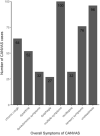CANVAS: a late onset ataxia due to biallelic intronic AAGGG expansions
- PMID: 32910249
- PMCID: PMC7914193
- DOI: 10.1007/s00415-020-10183-0
CANVAS: a late onset ataxia due to biallelic intronic AAGGG expansions
Abstract
The ataxias are a group of disorders that manifest with balance, movement, speech and visual problems. They can arise due to dysfunction of the cerebellum, the vestibular system and/or the sensory neurons. Genetic defects are a common cause of chronic ataxia, particularly common are repeat expansions in this group of conditions. Co-occurrence of cerebellar ataxia with neuropathy and vestibular areflexia syndrome has been termed CANVAS. Although CANVAS is a rare syndrome, on discovery of biallelic expansions in the second intron of replication factor C subunit 1 (RFC1) gene, we and others have found the phenotype is broad and RFC1 expansions are a common cause of late-onset progressive ataxia.We aim to provide a review and update on recent developments in CANVAS and populations, where the disorder has been reported. We have also optimised a protocol for RFC1 expansion screening which is described herein and expanded phenotype after analysing late-onset ataxia patients from around the world.
Keywords: CANVAS; Late-onset ataxia; RFC1; Repeat expansion; Southern blot.
Conflict of interest statement
The authors declare no conflicts of interest.
Figures



Similar articles
-
Biallelic RFC1 pentanucleotide repeat expansions in Greek patients with late-onset ataxia.Clin Genet. 2021 Jul;100(1):90-94. doi: 10.1111/cge.13960. Epub 2021 Mar 29. Clin Genet. 2021. PMID: 33745133
-
Biallelic expansion of an intronic repeat in RFC1 is a common cause of late-onset ataxia.Nat Genet. 2019 Apr;51(4):649-658. doi: 10.1038/s41588-019-0372-4. Epub 2019 Mar 29. Nat Genet. 2019. PMID: 30926972 Free PMC article.
-
Repeat conformation heterogeneity in cerebellar ataxia, neuropathy, vestibular areflexia syndrome.Brain. 2022 Apr 29;145(3):1139-1150. doi: 10.1093/brain/awab363. Brain. 2022. PMID: 35355059
-
An Updated Canvas of the RFC1-mediated CANVAS (Cerebellar Ataxia, Neuropathy and Vestibular Areflexia Syndrome).Mol Neurobiol. 2025 Jan;62(1):693-707. doi: 10.1007/s12035-024-04307-0. Epub 2024 Jun 19. Mol Neurobiol. 2025. PMID: 38898197 Review.
-
Cerebellar ataxia, neuropathy and vestibular areflexia syndrome (CANVAS): genetic and clinical aspects.Pract Neurol. 2022 Feb;22(1):14-18. doi: 10.1136/practneurol-2020-002822. Epub 2021 Aug 13. Pract Neurol. 2022. PMID: 34389644 Review.
Cited by
-
Cerebellar ataxia, neuropathy and vestibular areflexia syndrome (canvas): an important cause of late-onset ataxia with unique clinical features.Acta Neurol Belg. 2022 Aug;122(4):939-945. doi: 10.1007/s13760-021-01721-2. Epub 2021 Jun 8. Acta Neurol Belg. 2022. PMID: 34101140
-
Cognitive Dysfunction in Repeat Expansion Diseases: A Review.Front Aging Neurosci. 2022 Apr 11;14:841711. doi: 10.3389/fnagi.2022.841711. eCollection 2022. Front Aging Neurosci. 2022. PMID: 35478698 Free PMC article. Review.
-
Prevalence of intronic repeat expansions in the RFC1 gene in Polish patients with cerebellar syndrome.J Appl Genet. 2025 Aug 13. doi: 10.1007/s13353-025-01000-3. Online ahead of print. J Appl Genet. 2025. PMID: 40802152
-
Structural investigation of pathogenic RFC1 AAGGG pentanucleotide repeats reveals a role of G-quadruplex in dysregulated gene expression in CANVAS.Nucleic Acids Res. 2024 Mar 21;52(5):2698-2710. doi: 10.1093/nar/gkae032. Nucleic Acids Res. 2024. PMID: 38266156 Free PMC article.
-
Prevalence of intronic repeat expansions in RFC1 in Dutch patients with CANVAS and adult-onset ataxia.J Neurol. 2022 Nov;269(11):6086-6093. doi: 10.1007/s00415-022-11275-9. Epub 2022 Jul 21. J Neurol. 2022. PMID: 35864213 Free PMC article.
References
-
- Gebus O, Montaut S, Monga B, Wirth T, Cheraud C, Alves do Rego C, Zinchenko I, Carre G, Hamdaoui M, Hautecloque G, Nguyen-Them L, Lannes B, Chanson JB, Lagha-Boukbiza O, Fleury MC, Devys D, Nicolas G, Rudolf G, Bereau M, Mallaret M, Renaud M, Acquaviva C, Koenig M, Koob M, Kremer S, Namer IJ, Cazeneuve C, Echaniz-Laguna A, Tranchant C, Anheim M. Deciphering the causes of sporadic late-onset cerebellar ataxias: a prospective study with implications for diagnostic work. J Neurol. 2017;264:1118–1126. doi: 10.1007/s00415-017-8500-5. - DOI - PubMed
MeSH terms
Substances
Grants and funding
LinkOut - more resources
Full Text Sources

